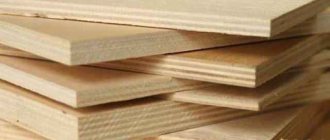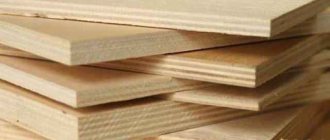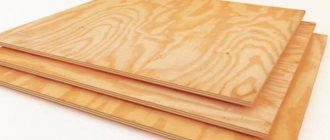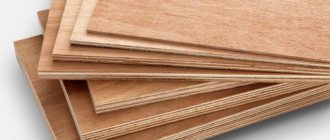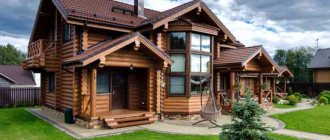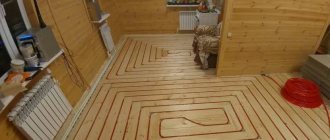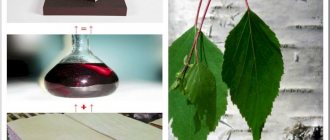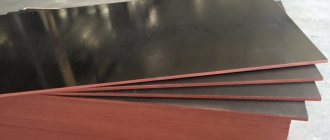Articles
All photos from the article
In this article we are going to get acquainted with a material that has characteristics that are quite unusual for a wood processing product. We will learn what moisture resistant marine plywood is and how and what it is made from. In addition, we have to study the standard regulating the requirements for its production.
Can ships be built from plywood? And how!
What it is
So, marine plywood – what is it? This is a layered veneer structure with the direction of the fibers changing from layer to layer. Bakelite varnish was used as impregnation and gluing material.
Please note: the more correct name for the material under which it appears in the price lists of suppliers is bakelized (bakelite) plywood.
The history of the material began shortly before the Great Patriotic War. The Soviet Union was actively rearming; The shortage of light aluminum and magnesium alloys has created a need for a material comparable in mechanical properties, but more affordable. The technology for its production was developed by chemist Ya.D. Avrasin and was immediately introduced by aircraft manufacturer V.P. Gorbunov.
At that time she looked like this:
- The veneer was glued together into sheets of considerable area;
- They were impregnated with bakelite varnish, a product of condensation of phenols and formaldehydes in an alkaline environment;
- A stack of the required thickness was placed under a press with steam-heated plates for drying.
The resulting layered cake was not much inferior to the strength of steel, but was much lighter and not afraid of moisture. Very quickly, bakelite plywood spread from the aircraft industry to another industry - the manufacture of small boats; a little later it began to be used in construction.
The photo shows outdoor furniture made of bakelite plywood.
Nowadays you can find two main categories of plywood on sale:
- Keruing and Okume marine plywood is made from veneer of exotic tropical species of the same name, and is characterized by a long service life and the highest mechanical strength. It is most often used in the construction of boats and yachts. However, it is produced exclusively abroad, so the price of the material (from 1,200 rubles per square meter with a thickness of 3 mm) makes it a rather expensive purchase;
- The domestic version is made from birch veneer and costs about half as much.
Domestic material.
Application
The high performance properties of bakelite plywood, primarily resistance to impact loads and atmospheric factors, allow it to be used in construction for both interior and exterior work. From rigid moisture-resistant FBS boards, you can build light garden buildings (summer kitchens, gazebos), canopies and podiums, assemble flooring for open areas, foundations for floors and roofs. They are also used for facade cladding of frame houses and the construction of partitions. For finishing ceilings, floors and walls indoors, thinner laminated FBV sheets are sufficient, which will perform excellently even in wet areas.
“Hard-wearing” shiplap plywood is an excellent option for making pieces of furniture, as well as for cladding a “windswept” front door. Since the material can be milled, the surfaces can be further decorated.
Manufacturers position bakelite plywood, in particular, as a material for the construction of formwork. But, given its cost, this can only be justified for reusable use.
Properties
Here are the properties of bakelite plywood that made it so popular in shipbuilding:
- Water resistance. It tolerates prolonged contact with fresh and salt water; Moreover, the minimum service life in the most extreme conditions is estimated at 15 years;
Kayak with plywood hull.
- Fire resistance. It doesn't burn; the material just begins to char with the release of a small amount of low-toxic smoke when reaching 350 degrees;
- Strength. As already mentioned, it is not much inferior to a steel sheet of similar thickness;
Curious: when cutting bakelite plywood with your own hands, without power tools, use a hacksaw. This instruction is related specifically to the strength of the material: a saw designed for wood will leave only small scratches on the workpiece.
- Resistant to all types of mold and mildew.
The density of the material is approximately 1150 – 1200 kg/m3. Bakelite is the only type of plywood that sinks in water.
Physical and mechanical properties of bakelized plywood
| Indicator name | Thickness, mm | Values for brands according to | Values for brands according to | |||
| FBS** | FBV | FBS-1**, FBV-1, FBS-1-A | FBS-1-A-T | FBV-1-T | ||
| Humidity, % | 5-7 | 6±2 | 8±2 | |||
| 8-40 | 8±2 | 10±2 | ||||
| Tensile strength along the fibers of the outer layers, MPa, not less | 5-7 | 88,0 | 78,5(88*) | 59,0 | 50,0 | |
| 10-12 | 73,5 | -(73,5*) | — | — | ||
| 14-40 | 68,5 | -(73,5*) | — | — | ||
| Ultimate strength during static bending across the fibers of the outer layers, MPa, not less than: | 7 | 78,5 | 63,5(78,5*) | — | — | |
| 10, 12 | 78,5 | 68,5(78,5*) | — | |||
| 14-40 | 88,2 | 78,5(78,5*) | — | |||
| Ultimate strength during static bending along the fibers of the outer layers, MPa, not less than: | 10,12 | 117,5 | 108,0(117,5*) | 88,0 | 65,0 | |
| 14-40 | 108 | 98,0(117,5*) | 78,5 | 55,0 | ||
| Tensile strength when chipping along the adhesive layer after boiling in water for 1 (2*) hours, MPa, not less: | 5-40 | 1,76 | 1,47(1,76*) | 1,47 | 1,47 | |
| Density, kg/m3, no more | 5-40 | 1200 | 1200 | |||
* - actual values of the FBV brand based on test results
** - currently these brands are not produced in Russia
Application of marine (ship) plywood
- In shipbuilding, bakelite plywood is used for bulkheads and cladding of small structures, for example, small boats. In common parlance, this type is called “marine plywood”, “ship plywood”, “deck plywood”, “boat plywood”, etc.
- In automotive and mechanical engineering. Under the prefix “A” in the marking, it is automobile production that is hidden.
- Backflywood also finds its application in construction work, incl. for the construction of formwork, construction of street scenes, etc.
Regulatory Requirements
They are contained in the British standard BritishStandard 1088/66 and in the domestic GOST 11539-83, adopted in 1985. We will have to take a closer look at the second document.
Stamps
The standard provides for the following brands:
| Brand | Peculiarities |
| FBS | Alcohol-soluble phenol-formaldehyde resin is used as glue and impregnation. The outer layers are impregnated with it; it is applied to the internal |
| FBS1 | Alcohol-soluble resin is applied to the outer and inner layers |
| FBV | For impregnation and gluing, water-soluble phenol-formaldehyde resin is used; in this case, the outer layers are impregnated with it, and it is applied to the inner ones |
| FBV1 | Water-soluble resin is applied to both the outer and inner layers |
Important: only FBS brand is used for deck structures and hulls of boats and boats.
Section of a sheet of FBS grade.
Dimensions
GOST provides for the production of bakelite plywood in the following sizes:
- Length – 1500, 4400, 4900, 5600, 5700, 7700 mm;
- Width – 1250, 1500, 1550 mm;
- Thickness – 5, 7, 10, 12, 14, 16 and 18 mm.
Technical requirements
They look like this:
- For production, only peeled birch veneer is used in accordance with GOST 99-96. This is due to the fact that birch wood is easily impregnated with bakelite varnish;
- The outer layers of plywood are made only from whole strips of veneer. Splices are allowed in the inner layers. In this case, the width of one strip must be at least 400 mm for the FBS brand and 200 mm for other brands;
- When compiling a sheet from strips, overlaps of up to 5 mm and gaps of up to 2 mm wide are allowed;
- The lines of longitudinal splicing of strips in the inner layers should not coincide in order for the strength of the sheet to be maximum;
- The surface of the sheet should not have areas uncoated or impregnated with resin;
- Overlaps, irregularities with a height or depth of more than 1 mm, bubbles and unpressed areas on the surface of the sheet are prohibited;
- Sheets are cut at right angles with a deviation of no more than 2 mm per linear meter;
- For the FBS grade with a thickness of over 6 mm, the edges must be protected with synthetic waterproof materials.
Features of manufacturing doors from ship plywood
For the manufacture of door panels, high-quality plywood sheets made of birch and oak veneer with a thickness of 12 mm or more are used. The production process uses industrial equipment that provides an average pressure of six atmospheres and a temperature of 270 degrees Celsius. When the primary cutting is completed, the workpiece is molded, varnished, and, if necessary, the wood is “aged.” To give the appearance of solid wood, the canvas is tinted using specialized dyes. If necessary, the product is supplemented with glass and metal inserts. After the door is manufactured, the fittings are installed.
provides services for the production of modern, temperature-resistant, outdoor products for your home, office, and other buildings. The manufacturer ensures the production process of door leaves in accordance with modern requirements. Using specialized equipment, tools, and veneer from high-quality wood species, craftsmen make strong, reliable structures that will serve for decades. You can always order doors in the required shade, with decor, additional fittings, metal and glass elements.
Advantages of bakelite plywood
Bakelized plywood FBS and FBV has the following advantages over competitive materials of this type:
high strength.
wear resistance.
Plywood has a long service life, which is achieved due to the specific properties of the impregnation, which does not evaporate for an extremely long time.
heat resistance/fire resistance.
No wonder the tank. plywood is used even in tropical conditions and in high-temperature industries - this material perfectly withstands temperatures of +50 degrees Celsius, does not catch fire or smolder.
frost resistance.
As you know, any material cannot be used for a long time in conditions of extreme cold - such as in Siberia or other frosty areas of the Earth. However, bakelite plywood is not afraid of temperatures of -50 degrees Celsius, while functioning perfectly.
moisture resistance.
Bakelized plywood 18 mm and no longer loses its strength and does not collapse under the influence of moisture. Add to this resistance to rot and insects/fungi and you get an ideal (though quite expensive) option for roof and attic floors.
chemical resistance influences.
Tank. plywood is not afraid of aggressive environments - gasoline, kerosene, other fuels and lubricants, acids, alkalis, sea water do not harm the material, so it can be used in any production.
resistance to the influence of fauna (no bark beetles, mold or mice can damage tank plywood).
Of course, a plywood tank also has its drawbacks. There are only a few of them:
heaviness.
Due to its impregnation, the specific gravity of the tank. plywood is slightly heavier than standard material, even if birch wood is used.
environmental unsafety.
Due to the fact that FBS plywood is extensively treated with carcinogenic materials, it is not recommended for use indoors. However, this does not apply to FBV plywood - an environmentally friendly material, which, however, has lower performance in other parameters.
high cost.
Of course, thanks to such impressive parameters, the tank. plywood and costs accordingly. However, we can say with certainty that this material will earn every penny invested with its characteristics and features.
As you can see, bakelite plywood, the technical characteristics of which are an order of magnitude superior to other materials, is an excellent product with an extremely wide range of applications.

